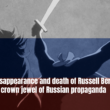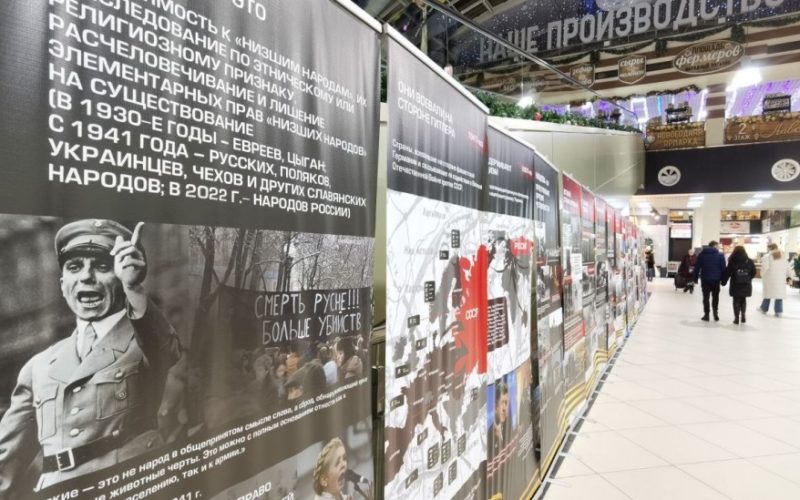A propaganda stand informing about “Nazism” in Ukraine was installed in Voronezh, Russia. On it, images of the leaders of Nazi Germany are accompanied by photographs of Ukrainian politicians, including Ukrainian President, Volodymyr Zelensky.
This is stated in the Telegram channel VORnadzor.
The information on Russian stands is fake
On the stand is a photo of protesters with the poster “Death to Russians! More killings”.
This is a photoshopped photo from a peaceful protest in Moscow in February 2009 in memory of the murdered lawyer Stanislav Markelov and journalist Anastasia Baburova. The original poster said: “Your silence is an excuse for murder.”
Lawyer Stanislav Markelov defended cases of human rights violations by Russian law enforcement officers in Chechnya and supported anti-fascists. Journalist Anastasia Baburova was engaged in informal youth movements, including neo-Nazi ones.
This event served as a catalyst for the consolidation of the anti-fascist movement throughout the post-Soviet space.
Lawyer Stanislav Markelov and Novaya Gazeta journalist Anastasia Baburova were murdered on the afternoon of 19 January 2009 on Prechistenka Street in central Moscow as they returned from a press conference.
Russian regime assures its citizens that Ukraine is a fascist state
After the death of these two innocents, the citizens of Russia commemorate their memory and go to protests. “Less fear – more freedom” is how they protested against the threat to human security.
Now Russian citizens continue to rebel to prevent fascism from happening again, but the authorities are trying to deceive people with propaganda that Ukraine is a fascist state.
The history of real fascism in Russia
Before Hitler’s rise to power in 1933, the Soviets treated fascists as just one more form of capitalist enemy. Communist parties in Europe were to treat all other parties as the enemy. This policy contributed to Hitler’s ascent: Though they outnumbered the Nazis, German communists and socialists could not cooperate.
After that fiasco, Stalin adjusted his policy, demanding that European communist parties form coalitions to block fascists.
That didn’t last long. In 1939, the Soviet Union joined Nazi Germany as a de facto ally, and the two powers invaded Poland together. Nazi speeches were reprinted in the Soviet press, and Nazi officers admired Soviet efficiency in mass deportations.
But Russians today do not speak of this fact since memory laws make it a crime to do so. World War II is an element of Mr. Putin’s historical myth of Russian innocence and lost greatness — Russia must enjoy a monopoly on victimhood and victory. The fact that Stalin enabled World War II by allying with Hitler must be unsayable and unthinkable.
Stalin’s flexibility regarding fascism is the key to understanding Russia today. Under Stalin, fascism was first indifferent, then bad. Then it was fine until — when Hitler betrayed Stalin and Germany invaded the Soviet Union — it was terrible again.
But no one ever defined what it meant. It was a box into which anything could be put. Communists were purged as fascists in show trials. During the Cold War, the Americans and the British became fascists. And “anti-fascism” did not prevent Stalin from targeting Jews in his last purge, nor did his successors from conflating Israel with Nazi Germany.
Soviet anti-fascism, in other words, was a politics of them and us. That is no answer to fascism. After all, fascist politics begins from the definition of an enemy, as the Nazi thinker Carl Schmitt said. Because Soviet anti-fascism just meant defining an enemy, it offered fascism a backdoor to return to Russia.
In Russia in the 21st century, “anti-fascism” became the right of a Russian leader to define national enemies. Actual Russian fascists, such as Aleksandr Dugin and Aleksandr Prokhanov, were given coverage in state media. And Mr. Putin himself has drawn on the work of the interwar Russian fascist Ivan Ilyin.
For the president, a “fascist” or a “Nazi” is simply someone who opposes him or his plan to destroy Ukraine. Ukrainians are “Nazis” because they do not accept that they are Russians and resist.
A time traveler from the 1930s would have no difficulty identifying the Putin regime as fascist. The symbol Z, the rallies, the propaganda, the war as a cleansing act of violence, and the death pits around Ukrainian towns make it very plain.
The war against Ukraine is not only a return to the traditional fascist battleground but also a return to traditional fascist language and practice. Other people are there to be colonized. Russia is innocent because of its ancient past. The existence of Ukraine is an international conspiracy. War is the answer.
Because Mr. Putin speaks of fascists as the enemy, we might find it hard to grasp that he could be a fascist. But in Russia’s war on Ukraine, “Nazi” means “subhuman enemy”— someone Russians can kill. Hate speech directed at Ukrainians makes it easier to murder them, as we see in Bucha, Mariupol, and every part of Ukraine that has been under Russian occupation, and where Russian soldiers committed war crimes.
Mass graves are not some accident of war but an expected consequence of a fascist war of destruction that Russia is waging against Ukraine.
Russia is losing support in its long war
“With such aggressive propaganda, it can be assumed that Russia is being prepared for an all-out war,” the statement said.
The “Vornadzor” stressed that the activists filed an application to the prosecutor’s office requesting a legal assessment of this stand. However, the statement was forwarded to the Russian Interior Ministry.
The new report from British intelligence says that among Russians, there is a significant decrease in support for the actions of the Russian army and the so-called “special military operation.” It is noted that in the future, it will be increasingly difficult for the Russian authorities to get the support of citizens because of the failures at the front in Ukraine.








